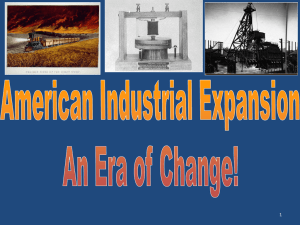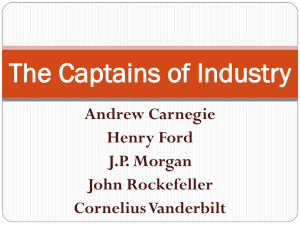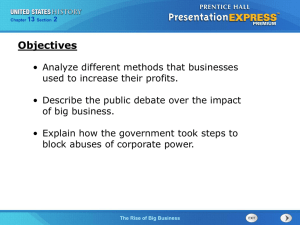Gilded Age - Williamstown Independent Schools
advertisement
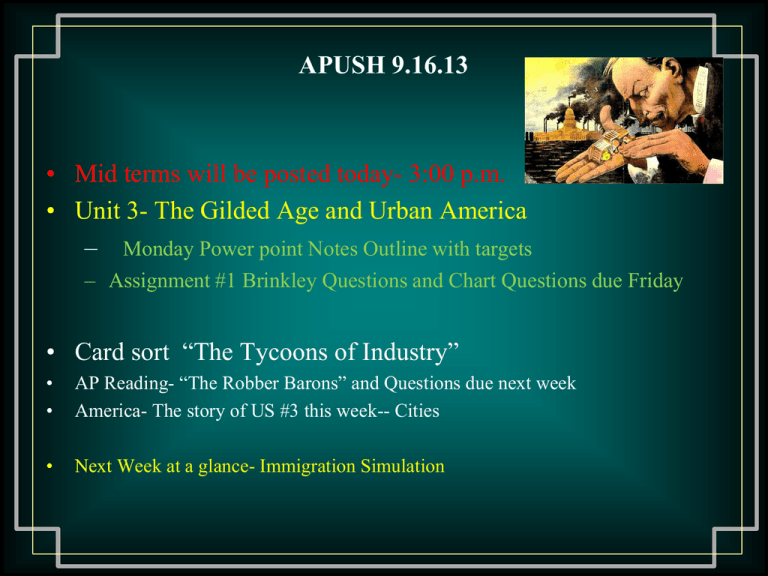
APUSH 9.16.13 • Mid terms will be posted today- 3:00 p.m. • Unit 3- The Gilded Age and Urban America – Monday Power point Notes Outline with targets – Assignment #1 Brinkley Questions and Chart Questions due Friday • Card sort “The Tycoons of Industry” • • AP Reading- “The Robber Barons” and Questions due next week America- The story of US #3 this week-- Cities • Next Week at a glance- Immigration Simulation U.S. History 9.16.13 • Mid terms will be posted today- 3:00 p.m. • Unit 3- The Gilded Age and Urban America – Monday Power point Notes Outline with targets – ASSIGNMENT – Guided Readings Chapter 9 -Questions due Friday • Card sort “The Tycoons of Industry” • America- The story of US #3 this week– Cities • Next Week at a glance- Immigration Simulation Cs. 9 & 17 ACT Common Core Standards for U.S. History Targets: We will…. • Evaluate the impact of new inventions and technologies of the late nineteenth century • Identify and evaluate the influences on business and industry in the late nineteenth and early twentieth centuries • Identify labor and workforce issues of the late nineteenth century, including perspectives of owners/managers and Social Darwinists The Gilded Age: • Mark Twain coined the phrase: Something that is gilded is covered with gold on the outside but made of cheaper material inside, sometimes corrupting and corroding. • Beneath the surface of a great Industrial Boom and increase in the overall standard of living for Americans, there lay beneath the surface: corruption, poverty, crime and great disparities in wealth between the rich and the poor. • The Gilded Age LEFT: The DOI is a Letter, a petition; 1776. It was where we were first called the United States; RIGHT: The Constitution is a Contract: a framework of government: it is Laws 1787 Happy Birthday to the U.S. Constitution • September 17, 1787 • How Old?? • 2013-1787= _______ • http://www.bluebullets.net/html/html/constituti on_scavenger_hunt.html • Or • Google: blue bullets constitution scavenger Essential Question Industrialization increased the standard of living and the opportunities of most Americans, but at what cost? The Gilded Age John D. Rockefeller The ‘Bosses’ of the Senate 7. Social and Economic Darwinism The Principle of the “Survival of the Fittest” Darwinism: Survival of the Fittest / Natural Selection was applied to economics Standard Oil Trust • Control of 90% of U.S. Refining Capacity • Through “Horizontal Integration” • Monopoly? Obstacles in Industry -Before this era, most women worked as SERVANTS -Many women were underpaid and factories were not safe -146 female workers died in the Triangle Shirtwaist Factory fire -While safety concerns abounded, progress was still made -The Bessemer Process of making steel made skyscrapers possible; elevators also made this possible -Daniel Burnham designed Chicago with a lakefront park system -Unions formed the Industrial Workers of the World to fight for the rights of factory labor; this is called COLLECTIVE BARGAINING -The government started the Interstate Commerce Act to lower excessive railroad rates -Yet, corruption abounded. For example, Credit Mobilier began to steal railroad money for share holders of stock APUSH 9.18.13 • 1. Pw-pnt. Notes– Page 2 Industrialization and the Rise of Big Business • Thomas Edison, Andrew Carnegie and Henry Ford – Turn in Notes Packet today to top tray– 30 points Pages 1-3 • 2. Chapter 17 Assignment: Reading and Questions • Tomorrow- America, The Story of US part 1– “The Cities” – During the 2nd part of class. IV. ACT Common Core Standards for U.S. History Targets: We will…. • Evaluate the impact of new inventions and technologies of the late nineteenth century • Identify and evaluate the influences on business and industry in the late nineteenth and early twentieth centuries • Identify labor and workforce issues of the late nineteenth century, including perspectives of owners/managers and Social Darwinists U.S. History 9.18.13 • 1. Pw-pnt. Notes– Page 2 Industrialization and the Rise of Big Business • Thomas Edison, Andrew Carnegie and Henry Ford – Turn in Notes Packet today to top tray– 10 points • 2. Chapter 9 Assignment: Guided Reading 9.1 Today– Packet Due Monday • Thursday/Friday– SIMULATED ACTIVITY– ASSEMBLY LINE AND DIVISION OF LABOR • John D. Rockefeller • America, The Story of US part 1– “The Cities” IV. ACT Common Core Standards for U.S. History Targets: We will…. • Evaluate the impact of new inventions and technologies of the late nineteenth century : – Bessemer Steel Process, Ediphone, Phonograph, AC/DC Current, Internal Combustible Engine, etc. • Identify and evaluate the influences on business and industry in the late nineteenth and early twentieth centuries: – Trusts, Monopolies, Corporations, Horizontal and Vertical Integration • Identify labor and workforce issues of the late nineteenth century, including perspectives of owners/managers and Social Darwinists – Labor Disputes, Social Darwinism, “Abusive Competition” and Capitalism Thomas Alva Edison “Wizard of Menlo Park” Thomas A. Edison The Incandescent Light Bulb The Phonograph (1877) The Ediphone or Dictaphone The Motion Picture Camera Alexander Graham Bell Telephone (1876) 3. Alternate Current George Westinghouse Niagara Falls 3. cont. Alternate Current Westinghouse Lamp ad The Airplane Wilbur Wright Orville Wright Kitty Hawk, NC – December 7, 1903 5. Model T Automobile Henry Ford I want to pay my workers so that they can afford my product! “Model T” Prices & Sales Henry Ford: Specialization and the Assembly Line • The Assembly Line • “Division of Labor” • “Specialization” Clip: History.com U. S. Patents Granted 1790s 276 patents issued. 1990s 1,119,220 patents issued. Andrew Carnegie • Tycoon of Steel– U.S. Steel: Pittsburgh, PA Henry Ford Home Insurance Building Steel Technology 6. The Heart of the Industrial Boom of the 1800s--The “Rust Belt” today 7. Steel Industry Iron & Steel Production 5. Bessemer Process The Bessemer Process for Steel Causes of Rapid Industrialization 1. Steam Revolution of the 1830s-1850s. 2. The Railroad fueled the growing US economy: First big business in the US. A magnet for financial investment. The key to opening the West. Aided the development of other industries. Causes of Rapid Industrialization 3. Technological innovations. Bessemer and open hearth process Refrigerated cars Edison o “Wizard of Menlo Park” o light bulb, phonograph, motion pictures. Causes of Rapid Industrialization 4. Unskilled & semi-skilled labor in abundance. 5. Abundant capital. 6. New, talented group of businessmen [entrepreneurs] and advisors. 7. Market growing as US population increased. 8. Government willing to help at all levels to stimulate economic growth. 9. Abundant natural resources. The Bessemer Process • 8. Free Enterprise • A. Laissez-fair, a French phase that means “let people do as they choose,” was a popular idea in the late 1800s. • B. Many believed government should not interfere with the economy. Instead they wanted supply and demand to regulate prices and wages. • Make an argument for both sides. Regulation and non-regulation today #3 New Approach to Management and Business Organization • III. Free Enterprise • A. Laissez-fair, a French phase that means “let people do as they choose,” was a popular idea in the late 1800s. UNRESTRICTED CAPITALISM!!! • B. Many believed government should not interfere with the economy. Instead they wanted supply and demand to regulate prices and wages. • Make an argument for both sides. Regulation and non-regulation today III. New Business Culture 1. Laissez Faire the ideology of the Industrial Age. Individual as a moral and economic ideal. Individuals should compete freely in the marketplace. The market was not man-made or invented. No room for government in the market! New Business Culture 1. Laissez Faire the ideology of the Industrial Age. Individual as a moral and economic ideal. Individuals should compete freely in the marketplace. The market was not man-made or invented. No room for government in the market! 2. Social Darwinism British economist. Advocate of laissez-faire. Adapted Darwin’s ideas from the “Origin of Species” to humans. Herbert Spencer Notion of “Survival of the Fittest.” 2. Social Darwinism in America $ Individuals must have absolute freedom to struggle, succeed or fail. William Graham Sumner Folkways (1906) $ Therefore, state intervention to reward society and the economy is futile! 7. Social and Economic Darwinism The Principle of the “Survival of the Fittest” Darwinism: Survival of the Fittest / Natural Selection was applied to economics New Business Culture: “The American Dream?” 3. Protestant (Puritan) “Work Ethic” Horatio Alger [100+ novels] Is the idea of the “self-made man” a MYTH?? Standard Oil Co. New Type of Business Entities 2. Trust: Horizontal Integration John D. Rockefeller Vertical Integration: o Gustavus Swift Meat-packing o Andrew Carnegie U. S. Steel Horizontal Integration: OIL Vertical Integration STEEL Yum Brands- Horizontal Integration Hot Pockets: Part of a Conglomerate #4. New Type of Business Entities 1. Pool 1887 Interstate Commerce Act Interstate Commerce Commission created. Quartz Mining 2. Trust John D. Rockefeller Standard Oil Co. #4. New Type of Business Entities 3. Corporation 4. Monopoly John D. Rockefeller Standard Oil Co. #6 Symptoms of Monopoly • The Industrial Power of the U.S. is controlled by just a few individuals and industries: “Powerful Corporations and Trusts”-1. John D. Rockefeller: Oil 2. Cornelius Vanderbilt: Railroads 3. Andrew Carnegie: Steel 4. J.P. Morgan: Finance and Banking #7 Natural Resources in Abundance in America • • • • • Trees Water Power Oil Iron Ore Coal John D. Rockefeller J.D. Rockefeller The ‘Bosses’ of the Senate #8 New Business Culture 1. Laissez Faire the ideology of the Industrial Age. Individual as a moral and economic ideal. Individuals should compete freely in the marketplace. The market was not man-made or invented. No room for government REGULATION in the market! New Type of Business Entities U. S. Corporate Mergers New Financial Businessman The Broker: J. Pierpont Morgan Wall Street – 1867 & 1900 The Reorganization of Work Frederick W. Taylor The Principles of Scientific Management (1911) The Reorganization of Work The Assembly Line % of Billionaires in 1900 % of Billionaires in 1918 The Protectors of Our Industries The ‘Bosses’ of the Senate The ‘Robber Barons’ of the Past Cornelius [“Commodore”] Vanderbilt Can’t I do what I want with my money? William Vanderbilt $ The public be damned! $ What do I care about the law? H’aint I got the power? The Gospel of Wealth: Religion in the Era of Industrialization $ Wealth no longer looked upon as bad. $ Viewed as a sign of God’s approval. $ Christian duty to accumulate wealth. $ Should not help the poor. Russell H. Conwell “On Wealth” $ The Anglo-Saxon race Andrew Carnegie is superior. $ “Gospel of Wealth” (1901). $ Inequality is inevitable and good. $ Wealthy should act as “trustees” for their “poorer brethren.” Regulating the Trusts 1877 Munn. v. IL 1886 Wabash, St. Louis & Pacific Railroad Company v. IL 1890 Sherman Antitrust Act in “restraint of trade” “rule of reason” loophole 1895 US v. E. C. Knight Co. Relative Share of World Manufacturing Modern ‘Robber Barons’?? Westward Migration Mining in the West: Gold in Colorado Transcontinental Railroad Cultures Class on the Prairie Expanding West -The federal government wanted people to go west -A homesteader was a person who got land from the federal government to settle west -As this occurred, more people were able to send beef back east; this lead to the Chisholm Trail. -The government created the Morrill Act that gave money to finance agricultural colleges -The Dawes Act was also created to help white settlers by poorly allocating land to Native Americans -Some worked on Bonanza farms, massive single crop farms owned by railroads and companies Bland-Alison Act: Back Money with Silver More and the West and Conflict -Another the government gave was the Homestead Act, which gave 160 acres to families in the west -Originally, the government gave huge reservations to the Indians, but this changed once whites wanted to move to the area -The government had a racist approach to giving land to Native Americans -The government had many skirmishes with Native Americans who resisted expansion; yet, the final battle, the massacre of Wounded Knee, ended this tension The Age of Railroads Organized Labor In Agriculture -The Grange formed to fight banks whom they felt were not treating them correctly -This movement gained some momentum; yet, it collapsed when William McKinley, an anti-populist candidate, was elected to office -Farmers felt that the rich were hording all the wealth due to the gold currency -Therefore, they wanted silver to be used for currency to put more money in circulation -This is called bimetallism -During this time, the town of Pullman arose -It was unique because it was built for the purpose of housing its workers in manufacturing & the railroad Oliver Hudson Kelley: Founder of the Grange The Grange Joseph Glidden: Inventor of Barbed Wire Notes on Sec. 1 the Rise of Industry • I. the US Industrializes • A. with the end of the Civil War, American industry expanded and millions of people left their farms to work in mines and factories • B. By the early 1900s, US had become the world’s leading industrial nation • By 1914 the gross national product (GNP), or total value of goods and services produced by a country, was 8x greater than at the end of the Civil War • C. Water, timber, coal, iron and copper are natural resources found in the US that lead to the countries industrial success • How did the construction of transcontinental railroads add to an increase in industrialization? • D. What were the early uses of Petroleum? • What industry was put out of business by the oil industry? Titusville, Pennsylvania 1859 • In 1859 Edwin Drake drilled the first oil well near Titusville, Pennsylvania. As oil production increased, so did economic expansion (See Previous Picture) • E. Between 1860 and 1910, the population of the US tripled. Why is this significant for industrialization? • II. Free Enterprise • A. Laissez-fair, a French phase that means “let people do as they choose,” was a popular idea in the late 1800s. • B. Many believed government should not interfere with the economy. Instead they wanted supply and demand to regulate prices and wages. • Make an argument for both sides. Regulation or non-regulation today • B. What is an Entrepreneur? • They risked their capital to run a business. In the late 1800s, they were attracted to manufacturing and transportation fields. • • As a result, hundreds of factories and thousands of miles of railroad were built. • Another important source of private capital was Europe. Why would foreign investors invest in American companies? • III. Government’s Role in Industrialism • A. In the late 1800s, government had a laissez-faire attitude by keeping taxes and spending low and by not imposing regulations on industry. • Who would this help? • Who would this hurt? • B. Since the early 1800s, Northern States and Southern States debated on economic policies. Why would the northern states want a tariff on manufactured goods? • Why would southern states oppose a tariff? • When the South seceded the Morrill Tariff was passed, which reversed years of declining tariffs. Why was Congress able to pass it passed during the Civil War? • C. Some Americans were harmed by this tariff. What would other countries do when the US raised tariffs? • Which group particularly would be harmed? Why? • By the early 1900s, American industries were large and highly competitive. Many business leaders now favored free trade, believing they could compete internationally and succeed. • Make a chart of the inventions and inventors on p. 311 and 312. #5 Social Darwinism Arises -Social Darwinism discouraged government regulation and claimed the strongest companies should survive -This lead to monopolies; yet, legislation like the Sherman Antitrust Act outlawed the formation of trusts that interfered with free trade IN ORDER TO CREATE MORE COMPETITION -Vertical Integration occurred, where companies tried to by out all raw resources for their products -Horizontal Integration also occurred, where companies bought out similar companies -Strikes were used by labor to fight back, such as the Great Strike of 1877 in the railroad industry -The railroads allowed cities to expand OUTWARD and time zones were made mainly to benefit railroad companies & travelers
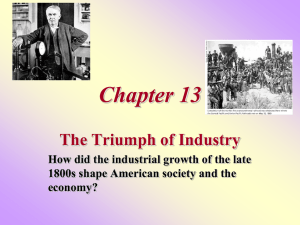
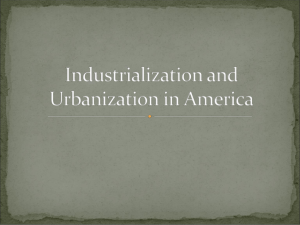

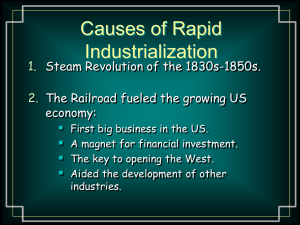
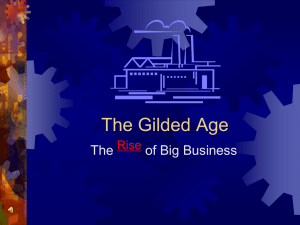
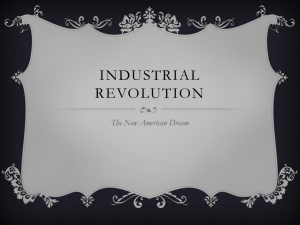

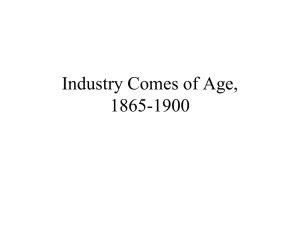

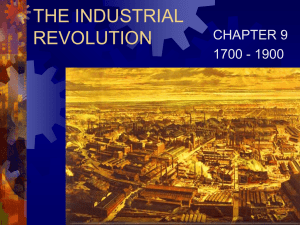
![men_who_built_america[1]](http://s2.studylib.net/store/data/005219845_1-7979604da89ac700f7913bb56611cc41-300x300.png)
